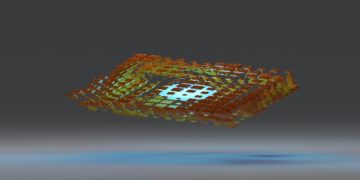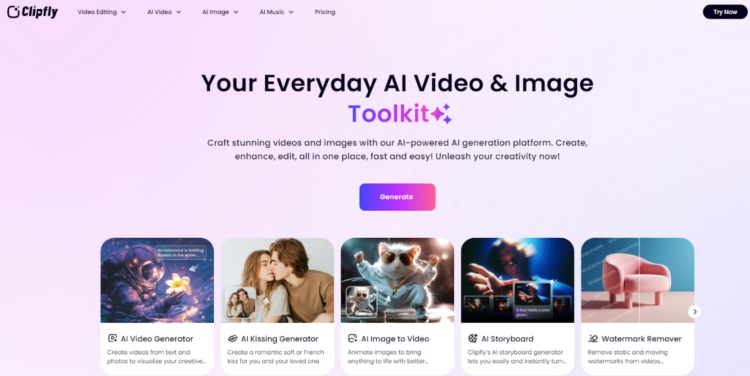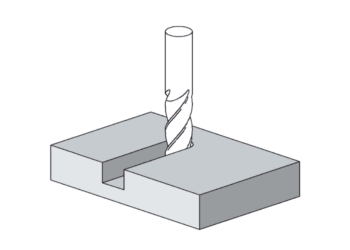Video production is changing at a level that is equal to the one that occurred when the industry switched to digital. With more than 80 percent of the internet traffic being video content, the need to create video scales faster than ever has never been as high. Now update AI-assisted video creation: technology that will turn ideas into visual stories with the least amount of human interaction. Of the platforms that are at the forefront, Clipfly AI Video Generator is one of the most holistic tools that enables automation of video creation based on narrative prompts as well as video and audio media.
So what is so special about this technology? What does it actually do to automate the complex process of making videos? More importantly, what does that imply on the side of creators, marketers and businesses that will have to survive the content requirements of 2025? It is time to explore the mechanics, abilities, and implications of this new tool in detail.
Inverting the AI Video Generation Pipeline
The classical approach to video production is linear and has been characterized as labor intensive: scripting, storyboarding, shooting, editing, color grading, and post production. Each phase requires specialized skills and tools. In contrast, modern solutions like the Clipfly AI video generator disrupt this process by condensing multiple stages into one automated pipeline.
It starts with natural language processing. By entering a text prompt, such as a cyberpunk cat walking the neon-lit streets in Tokyo in the middle of the night, the system uses highly developed language models to understand the semantic meaning, find visual evidence (subjects, settings, lighting, mood), and determine style preferences. It is not an easy key-word matching, but an understanding of the context that understands that the term cyberpunk connotes certain colour palettes, architectural forms and a mood.
Then the platform chooses between several generation models. Clipfly incorporates a number of the latest AI engines, such as Veo 3, Flux, Wan 2.5, Seedance, and Kling. The models have their own strengths, as some of them are photorealistic, others are stylized. Such a capability of model switching enables users to align the strong points of the AI to their creative vision, which makes this feature the difference between professional-grade platforms and single-model ones.
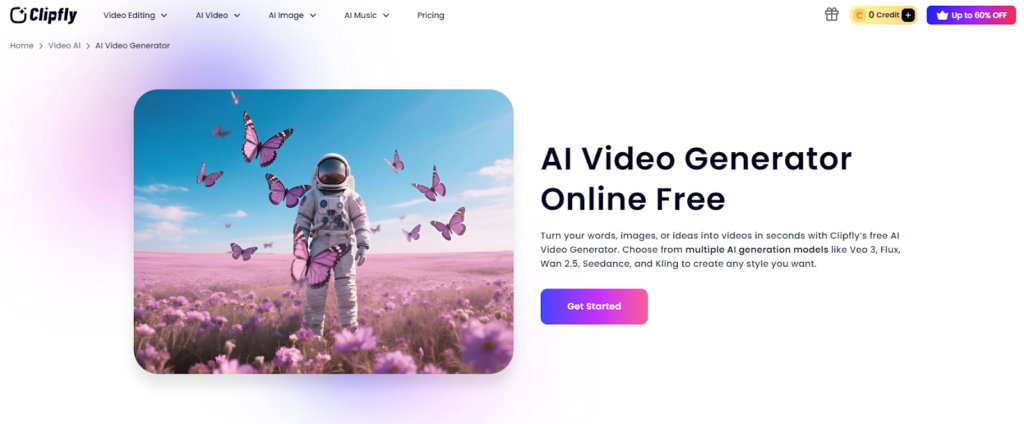
Core Automation Features: From Static to Cinematic
Text-to-Video: Ideas Materialized
At the heart of Clipfly’s automation is its text-to-video engine. Users describe scenes in natural language—defining subjects, movements, camera angles, and details—and the system brings them to life. It supports multilingual input, processing prompts in English, German, Chinese, and more with equal precision. Beyond simple generation, Clipfly automatically selects backgrounds, calculates camera movements, applies filters, and even suggests pacing. A prompt like “gentle waves” produces smooth, slow motion, while “action sequence” triggers fast, dynamic transitions.
Crucially, Clipfly maintains subject consistency throughout—ensuring narrative coherence. Whether it’s a 4-second clip or a longer sequence, the AI tracks characters and objects to prevent the morphing artifacts that once plagued earlier video AI.
Image-to-Video: Breathing Life into Stills
The image-to-video pipeline is equally impressive. Users upload a photo and direct the AI to animate chosen elements. The system separates foreground, background, and objects, applying tailored motion to each for lifelike animation. This segmentation-based approach gives creators control—make the Mona Lisa smile, spin a product 360°, or zoom out from a landscape. The “movement amplitude” feature offers Small, Medium, Large, or Auto settings for fine-tuned motion.
Behind the scenes, Clipfly uses computer vision to analyze depth, object boundaries, and physics. It infers skeletal motion for people and realistic rotations or deformations for objects.
Multi-Image Narrative Synthesis
Clipfly’s multi-image-to-video feature showcases its most advanced automation. By uploading foreground, background, and motion elements, users can merge them into a cohesive animated scene.
Imagine combining a CEO portrait, an office background, and a gesture illustration—the AI blends them seamlessly into a video of the executive presenting in that space. This element-wise fusion marks a major step beyond simple transitions, enabling complex storytelling without manual compositing.
First-and-Last Frame Storytelling
The platform’s “first & last frames” feature automates transformation sequences. Upload a “before” and “after” image, describe the intermediate narrative, and the AI generates the transitional journey. This proves invaluable for:
- Product evolution showcases (concept sketch to final design)
- Character transformation scenes (ordinary person to superhero)
- Temporal progressions (child to adult)
The automation calculates the visual morphing path, generates intermediate frames, and applies consistent lighting and color grading throughout—tasks that would require hours in traditional animation software.
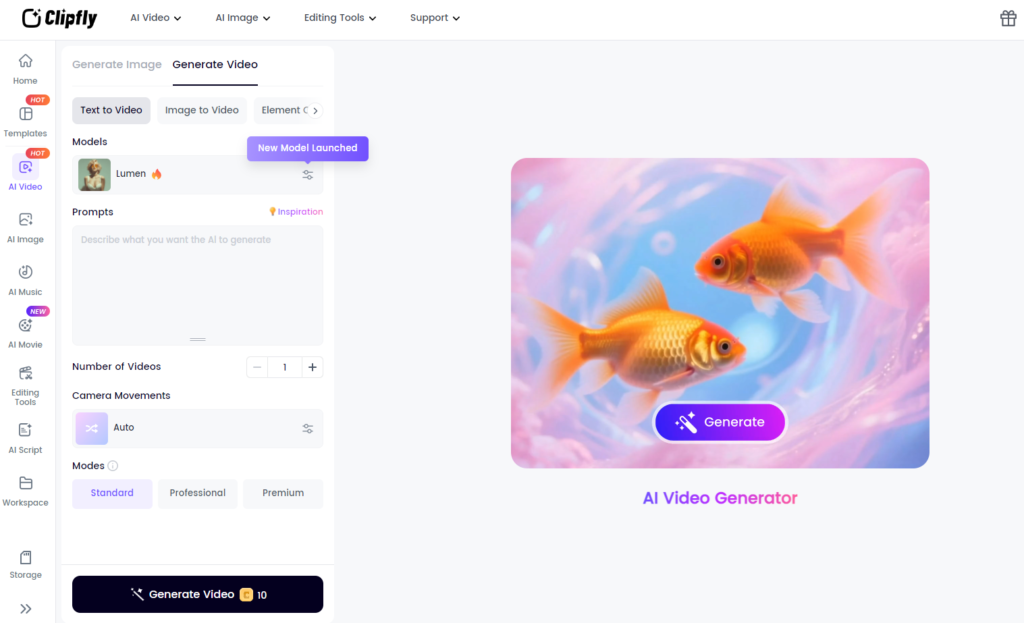
Workflow Integration: The One-Stop Toolkit Philosophy
Automation’s value multiplies when tools integrate seamlessly. Clipfly positions itself as a comprehensive creative suite rather than a single-purpose generator. This ecosystem approach automates the entire post-generation pipeline:
- Batch Generation: Create multiple video variants simultaneously, letting the AI explore different interpretations of your prompt. This automated A/B testing capability helps identify the most compelling version.
- In-Browser Editing: Trimming, cropping, rotation, and flipping happen without leaving the platform. The AI suggests optimal cut points based on action peaks and scene changes.
- Smart Asset Integration: A built-in library of stock music, filters, transitions, and stickers is automatically suggested based on video content and style. When it comes to a corporate presentation, it is not associated with musical suggestions of the same nature as with fantasy adventure.
- Automated Captioning: Speech (or text overlay) recognition is followed by automated subtitles, which is useful in imports of SRT files to ensure accurate timing.
- Format Optimization: The format of video exports based on the specific aspect ratios of the platform, such as vertical on Tik Tok, square on Instagram, and widescreen on YouTube, and the AI reformatting of shots to ensure the presence of focal points.
Such consolidation does away with tool-hopping which has traditionally fractured workflows in creativity. A study by Creative Software Alliance found that creators typically switch between 5-7 applications per project; Clipfly reduces this to one.
Use Cases: Automation Across Industries
- Marketing & E-commerce: Product teams generate multiple video ads by simply describing features. Instead of organizing costly photoshoots, marketers input “smartphone rotating with spec highlights” and receive ready-to-publish content. The AI automatically applies brand colors and styles when prompted.
- Education: Instructors convert lesson plans into visual explainers. A biology teacher types “mitosis process in cell division” and receives an accurate animation. The system automatically labels structures and includes appropriate terminology overlays.
- News Media: Clipfly’s talking avatar feature automates presenter videos. Input a script, select a digital anchor, and generate broadcast-ready segments. This addresses the 24/7 news cycle’s insatiable content appetite without requiring human presenters for every update.
- Social Media Management: Agencies serving multiple clients use batch generation to create weeks of content in hours. The AI automatically adapts styles—playful for a toy brand, sophisticated for a law firm—based on simple prompt modifications.
- Independent Filmmaking: Pre-visualization, once a costly storyboard process, becomes automated. Directors generate rough-cut sequences from scene descriptions, using these AI drafts to refine shooting plans and secure funding.
Under the Hood: Advanced Controls for Power Users
While automation implies simplicity, Clipfly offers granular controls for technical users:
- Model Selection: Choose between Veo 3 for realism, Kling for speed, or Flux for artistic interpretation.
- Camera Parameters: Specify “dolly-in,” “pan left,” “crane shot” directly in prompts.
- Negative Prompting: Exclude unwanted elements (“no people,” “avoid dark colors”).
- Seed Values: Reproduce specific results for iterative refinement.
- Motion Intensity: Fine-tune animation from subtle to dramatic.
These controls satisfy tech-savvy creators who want automation efficiency without sacrificing creative precision.
Pricing and Packages: Accessibility Meets Scalability
Understanding the cost structure is crucial for implementation planning. Clipfly employs a freemium credit-based model:
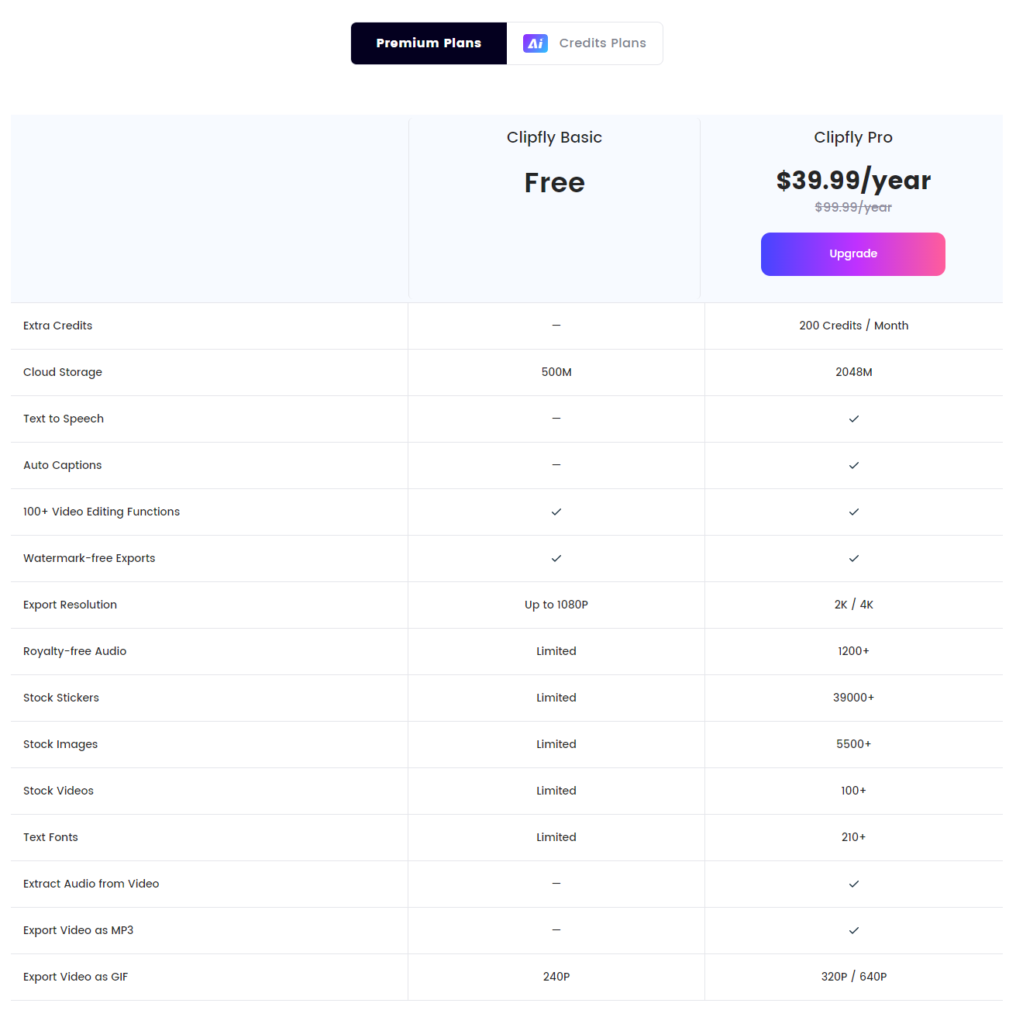
Free Plan ($0/month):
Includes access to core AI video and image generators with a monthly credit allocation. Users receive watermark-free 1080p exports and can experiment with most features. Generation priority is lower, which may result in longer queue times during peak hours.
Pro Plan ($39.99/year, approximately $3.33/month):
Offers 200+ AI credits monthly with standard licensing. This tier provides faster generation, priority processing, and access to premium style templates. The annual billing makes it accessible for individual creators and small businesses.
Custom Plan (Quote-based):
Designed for enterprise teams requiring dedicated support, higher credit volumes, advanced collaboration features, and expanded commercial licensing. This tier often includes API access for integrating Clipfly’s automation into existing production pipelines.
The credit system operates on a per-generation basis, with costs varying by video length, resolution, and model complexity. Users should note that credits expire monthly, encouraging active use but potentially disadvantageous sporadic creators. For high-volume production, the Custom plan’s predictable pricing likely proves more economical than purchasing top-up credits repeatedly.
The Other Side: Limitations and Considerations
No technology is without constraints. Understanding these helps set realistic expectations:
- Complex Prompt Adherence: While Clipfly excels at straightforward scenes, highly intricate narratives with multiple character interactions can challenge the AI. The system may simplify or misinterpret nuanced plot points, requiring prompt engineering iterations.
- Free Tier Performance: Lower priority processing means generation times can extend to several minutes or stall during server load. For time-sensitive projects, the Pro plan’s priority queue becomes necessary.
- Format Support: Currently, Clipfly exports exclusively in MP4 format. Professionals requiring ProRes for broadcast or WebM for web optimization must use external converters, slightly undermining the “one-stop” promise.
- Credit Economics: The 200 monthly credits on the Pro plan deplete quickly during experimentation. Each test generation consumes credits, potentially limiting creative exploration. Heavy users might find themselves purchasing additional packs, increasing total costs.
- Temporal Consistency: Although this has significantly improved, ensuring a perfect character consistency in extremely long sequences (30 seconds and above) is still a challenge that is taken by the industry. Morphing may creep in or drift by subtle attributes and these need to be reviewed manually.
These constraints do not make the platform less valuable but present the platform as a complement to, not full replacement of, more traditional production in high stakes situations.
Conclusion: The Automated Creative Future: Welcome to It
Clipfly AI Video Generator is not just a convenience product, it is the paradigm shift of the idea-to-visual-media translation tool. It frees creators to foresee through storytelling, strategy, and emotional appeal due to the automation of the technical heavy lifting of video production.
To technical specialists considering this technology, the calculus is simple; the time savings, cost reduction, and creative flexibility all massively favor experimentation. The free option offers risk-free exploration, with the Pro plan of 3.33 dollars per month being insignificant against conventional costs of production.
What is really innovative about the platform is not the ability to substitute human creativity, but rather to remove technical roadblocks of the repetitive type. The vision of the director, the message of the marketer, the explanation of the educator all these are something that cannot be replaced by human beings. Clipfly just eliminates the months of training and costly machinery that in the past used to keep conception and realization apart.







